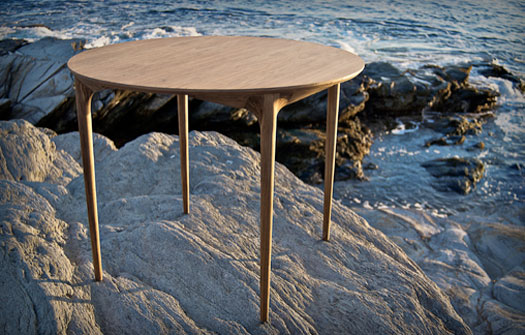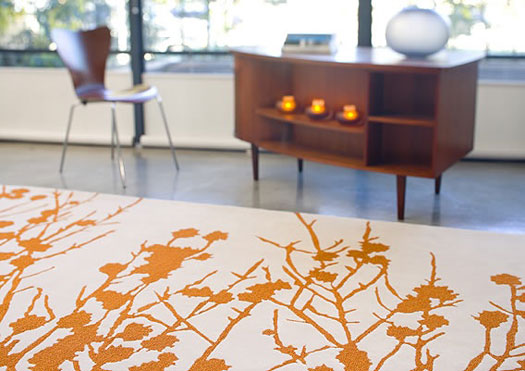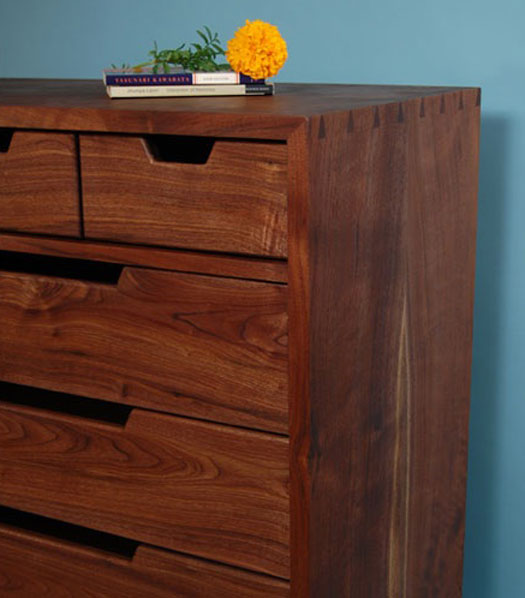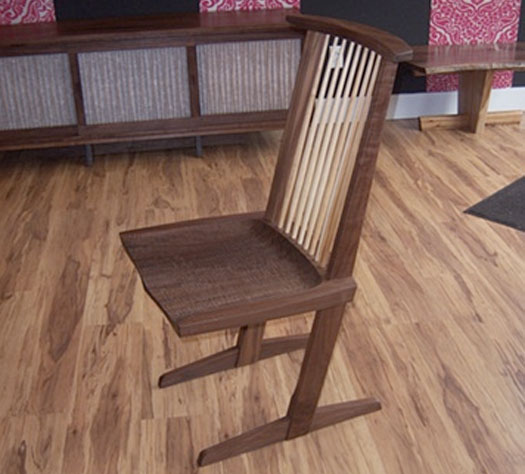
Newport table, Studio Dunn
Last January, in the depths of the economic slump, design writer Michael Cannell suggested in a provocative New York Times article that an economic downturn might be just the thing the design world needs. After all, he argued, “design tends to thrive in hard times,” citing the work of Russel Wright in the Great Depression and the Eames’ creations in the post-war 1940s. And after the boom years brought us celebrity designers and architects, soaring prices for sofas, and wild antics at design fairs, Cannell figured the time had arrived for the design world to “come down a notch or two” and by so doing “find a new sense of relevance.”
The writer was roundly condemned in some circles for his “Design Loves a Depression” piece. Although the contretemps soon died down I couldn’t help but recall the controversy while wandering through this year’s International Contemporary Furniture Fair, which rolled into New York’s Javits center on May 15, at a time when global financial markets were teetering on the edge and the recession still haunted the great majority of us. The booths, numbering almost 600, were full of wares ranging from dull to inspiring, and a lot in between. Although there was no major trend to decipher, one lasting impression was the energy and enthusiasm of many of the younger designers, both students and those already trying to get businesses going. There was griping, to be sure — about slipping sales, the difficulties of finding distribution, and moving products from prototype to production — but there was also evidence amid the grumbling of hard work and optimism and new ideas.



It’s impossible to place these designers and what they are doing on a definitive time line, to say whether the gloomy economic climate and national sour mood pushed them in these directions, or whether they are demonstrating a natural evolution of ideas. What was clear, however, was that poking through the mass of furniture, lighting, materials, rugs and wall coverings at the show this year was a glimpse of design aiming for something new — a new sense of relevance.
Last January, in the depths of the economic slump, design writer Michael Cannell suggested in a provocative New York Times article that an economic downturn might be just the thing the design world needs. After all, he argued, “design tends to thrive in hard times,” citing the work of Russel Wright in the Great Depression and the Eames’ creations in the post-war 1940s. And after the boom years brought us celebrity designers and architects, soaring prices for sofas, and wild antics at design fairs, Cannell figured the time had arrived for the design world to “come down a notch or two” and by so doing “find a new sense of relevance.”
The writer was roundly condemned in some circles for his “Design Loves a Depression” piece. Although the contretemps soon died down I couldn’t help but recall the controversy while wandering through this year’s International Contemporary Furniture Fair, which rolled into New York’s Javits center on May 15, at a time when global financial markets were teetering on the edge and the recession still haunted the great majority of us. The booths, numbering almost 600, were full of wares ranging from dull to inspiring, and a lot in between. Although there was no major trend to decipher, one lasting impression was the energy and enthusiasm of many of the younger designers, both students and those already trying to get businesses going. There was griping, to be sure — about slipping sales, the difficulties of finding distribution, and moving products from prototype to production — but there was also evidence amid the grumbling of hard work and optimism and new ideas.

Branches O rug, Indi-B
Among the young designers was Freddy Hill, who proudly talked about working out of a former bomb factory in Cleveland, where the rent is a pittance compared to that of more high priced cities. Standing in his tiny booth next to a wood credenza with paper-covered doors, he spoke about how he tries to source materials locally and the continuing challenge of finding places to sell his work. In another booth were Chris Armes and Sharon Khosla of 16th Workshop in Seattle. This-husband-and-wife team said they build furniture in their garage, and were showing a sturdy chest of drawers made of Western walnut boards featuring hand-cut dovetails and turned legs. “Good design makes us more observant participants in our world and thereby helps us to recognize the value and beauty that surrounds us every day,” it says on their website, which shows the couple in their kitchen with their baby (Hill’s site also features his son, noting that he is a serious person but “on those rare occasions when he lightens up, he’s usually suffocating his son with kisses.”)
Among the young designers was Freddy Hill, who proudly talked about working out of a former bomb factory in Cleveland, where the rent is a pittance compared to that of more high priced cities. Standing in his tiny booth next to a wood credenza with paper-covered doors, he spoke about how he tries to source materials locally and the continuing challenge of finding places to sell his work. In another booth were Chris Armes and Sharon Khosla of 16th Workshop in Seattle. This-husband-and-wife team said they build furniture in their garage, and were showing a sturdy chest of drawers made of Western walnut boards featuring hand-cut dovetails and turned legs. “Good design makes us more observant participants in our world and thereby helps us to recognize the value and beauty that surrounds us every day,” it says on their website, which shows the couple in their kitchen with their baby (Hill’s site also features his son, noting that he is a serious person but “on those rare occasions when he lightens up, he’s usually suffocating his son with kisses.”)

High chest, 16th Workshop
It appeared that many of the designers were ready to show off not only their kids but also their socially aware and sustainable credentials and philosophical underpinnings, and none of these outreach efforts seemed hokey or contrived or calibrated for public-relations impact. The social agenda at the Los Angeles rug company Indi-B, for example, ran the gamut from natural dyes and fibers in beautiful floral pattern pieces to certification that all the products are produced in child-labor-free facilities, as prescribed by GoodWeave, an organization that monitors the handmade carpet industry and provides opportunities to rescue at at-risk youngsters (it’s estimated that the industry exploits nearly 250,000 children).
Of course, there were big names at the show, like Tom Dixon and Patricia Urquiola. Spain and Austria showcased their top talent with polished displays. Minneapolis-based Blu Dot picked up a best-body-of-work award. But there was also room for upstarts like a woodworking design team (or call it a collective) named Studio Dunn based in Pawtucket, R.I. These recent Rhode Island School of Design grads make exquisite furniture from FSC-certified wood and create hand-blown glass lamps, and all production is done by craftspeople located within 50 miles of their workshop. It’s all part of the studio’s goal to support local businesses and communities in a place where the U.S. industrial revolution was born and is struggling to survive.
It appeared that many of the designers were ready to show off not only their kids but also their socially aware and sustainable credentials and philosophical underpinnings, and none of these outreach efforts seemed hokey or contrived or calibrated for public-relations impact. The social agenda at the Los Angeles rug company Indi-B, for example, ran the gamut from natural dyes and fibers in beautiful floral pattern pieces to certification that all the products are produced in child-labor-free facilities, as prescribed by GoodWeave, an organization that monitors the handmade carpet industry and provides opportunities to rescue at at-risk youngsters (it’s estimated that the industry exploits nearly 250,000 children).
Of course, there were big names at the show, like Tom Dixon and Patricia Urquiola. Spain and Austria showcased their top talent with polished displays. Minneapolis-based Blu Dot picked up a best-body-of-work award. But there was also room for upstarts like a woodworking design team (or call it a collective) named Studio Dunn based in Pawtucket, R.I. These recent Rhode Island School of Design grads make exquisite furniture from FSC-certified wood and create hand-blown glass lamps, and all production is done by craftspeople located within 50 miles of their workshop. It’s all part of the studio’s goal to support local businesses and communities in a place where the U.S. industrial revolution was born and is struggling to survive.

George's Chair, Bomb Factory Furniture
It’s impossible to place these designers and what they are doing on a definitive time line, to say whether the gloomy economic climate and national sour mood pushed them in these directions, or whether they are demonstrating a natural evolution of ideas. What was clear, however, was that poking through the mass of furniture, lighting, materials, rugs and wall coverings at the show this year was a glimpse of design aiming for something new — a new sense of relevance.
